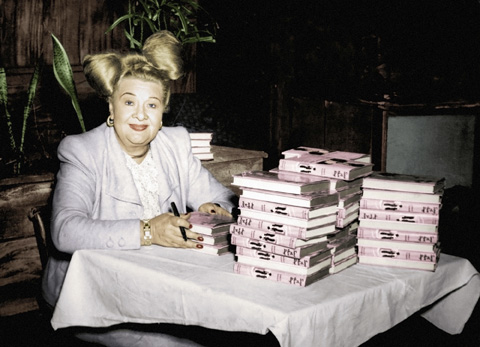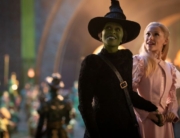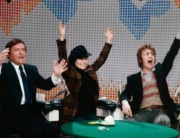The Outrageous Sophie Tucker takes a breezy, mostly chronological tour through the on- and off-stage life of the singular entertainer, whose singing career extended from the birth of vaudeville to the rise of television. The biodoc is strongest when it reveals her innovations in musical style and marketing, and weakest when it strings together anecdotes, however amusing.
Director William Gazecki starts off with biographers/producers/narrators Susan and Lloyd Ecker. They explain that they became fascinated with Tucker through their love of Bette Midler, who credits Tucker as an influence. (Unfortunately, she is not interviewed.) Then they excitedly talk about the four years they spent going through Tucker’s 400-plus scrapbooks that she donated to Brandeis University and the New York Public Library. They contain every piece of paper that passed through her hands—flyers; telegrams; notes; greeting cards; photographs with the famous, fans, and family—from 1906 to 1966. These original materials are seen in constant montages. The Eckers spent another four years traveling to find everyone and every place referenced (through 14 states and to England) and to interview those still living in order to separate fact from fiction in her autobiography and many accounts. Impressive archival photographs and footage supplement the ephemera, though efforts at animating stills just look stiffly silly.
Tucker was born Sonya Kalish en route from the Ukraine to Hartford, Connecticut, in 1887, where her immigrant Jewish parents settled. From childhood on, she sang in her family’s restaurant and discovered the temptations of vaudeville while trying to get the mostly Jewish performers to come in as customers. A brief marriage produced a son and gave her the last name Tuck, leading to her stage name when she ran away to New York, singing anywhere she could, including between one-reel movies. A feminist scholar notes that in 1907, a man leaving his family to send money back home would not be unusual, but it was for Tucker as a woman to do so.
In all the references to the zaftig Tucker, there’s a gap in how she developed her big, brassy, bluesy, suggestively sexual style of emphasizing double entendres that she parlayed into her “Red Hot Mama” persona by the 1920s. Michael Feinstein, as a leading expert on American popular song, is the most helpful in explaining that such stylings were called “coon shouters”: “She was the greatest of the coon shouters because of the power of her voice.” The biographers hasten to excuse how producers forced her to perform with a Southern accent in corked blackface in 1908, which she detested and “forgot” to apply for good on an out-of-town tour. But given that Al Jolson’s appropriation of blackface minstrelsy made him a popular contemporary performer, more exploration of the interplay between black and white female performers would have added insight.
There are unexplored hints that she must have been familiar with African-American popular music in these years before the voices of Ma Rainey and Bessie Smith reached north on records. (Tony Bennett, who toured with Tucker, calls her “the most underrated jazz singer who ever lived”—but he almost said exactly that about Amy Winehouse’s potential in Amy. Left unmentioned, though heard, is that one of her signature tunes, “Some of These Days,” was written by African-American songwriter Shelton Brooks. Or that another of her famous songs, “I Ain’t Got Nobody,” was also a hit for the first African-American crossover star, Bert Williams. His name quickly goes by on a shared bill flyer, and they passed through the Ziegfeld Follies the same season (though she lost her place by getting more applause than the now forgotten female headliner).
The biographers do compare her with Jolson in analyzing why her movie career fizzled, first in what Tucker herself called “the stinkeroo” Honky Tonk (1929). Her key song “Last of the Red Hot Mamas” was the only lasting souvenir. She didn’t try Hollywood again until Broadway Melody of 1938, which became more notable for the performance of her protégé Judy Garland. But she didn’t need to be a movie star to be the “Yiddishe Momme” for American soldiers during World War II. A long letter, read by David Hyde Pierce, tells of a troop playing her popular record on the streets of occupied Berlin in tribute to a fallen Jewish comrade.
As seen in many photographs and posters, with snippets of songs, her milieu was nightclubs and theaters. During Prohibition, she worked comfortably with gangsters (there’s anecdotes about her playing cards with Al Capone in Chicago). J. Edgar Hoover enjoyed coming to her shows with Clyde Tolson and supposedly asked for her glamorously over-the-top dresses that emphasized her ample frame. Also, Barbara Walters has some vague remembrances about Tucker filling her father’s Latin Quarters clubs in New York and Miami.
Tucker was the first client of William Morris, and, like all her business arrangements, the partnership was based on a handshake, including with her accompanist and frequent songwriter of almost 40 years, Tony Shapiro. More notable were her endless marketing efforts to fill all those seats, which included selling autographed items in the lobby after the show. In later years, she claimed the collections “were for Israel,” but there are shrugs by the likes of comedian Shecky Greene when questioned if that was true. Into the 1960’s, she timed her tours around her twice-a-year guest spots on The Ed Sullivan Show.
Amidst a stream of anecdotes (such as from Carol Channing and Brenda Lee), right through the credits, photographs illustrate brief remembrances of her personal life, about her several husbands, a difficult son, and female traveling companions. But it’s annoying that from the beginning the filmmaker presumes that any photograph taken of Tucker with another performer, president, royal, or any famous person means they were “close friends.” It just seems like air-kissing phoniness. Returning to her continuing influence on women in popular music and her self-promotion (even 50 years after her death) would have been a more significant tribute.







Leave A Comment